What are the 4 main areas of digital transformation?
That depends on who you ask…
In this article, we’ll look at a number of resources that provide a wealth of ideas and perspectives on digital transformation.
Digital transformation meaning refers to implementing digital technologies to unlock the total value of your digital technologies.
What Is Digital Transformation?
Digital transformation is a term that has been used for years to describe transforming business processes in an organization from their current state into one where it can compete in today’s digital world. Gartner, Inc. first introduced the concept; since then, many companies have adopted this strategy to help them become more competitive.
The goal of digital transformation is to create a new business model that allows organizations to be more efficient and effective at what they do. This means businesses will need to make changes across all departments, including marketing, sales, customer service, product development, etc., to succeed in their digital transformation efforts.
The four primary areas of digital transformation include:
- Customer Experience (CX)
- Data & Analytics
- Cloud Computing
- Mobility
To achieve these goals, there needs to be a change in mindset within the entire organization. It’s not enough to hire people who know how to use digital technology; you also need to train them to work together as a team.
In addition, the company needs to understand its customers better to provide a better experience. They should also collect customer data to determine which products or services best meet their needs.
Finally, enterprises need to embrace mobility because most employees use smartphones and tablets to access information. If they don’t, they risk losing out on business.
What Are the 4 Main Areas of Digital Transformation?
Some experts and thought leaders advocate models that focus on 4 main areas of digital transformation.
Others follow models that emphasize anywhere from 3 to 9 areas…
So what is the best model to follow?
And who should you listen to?
It’s best to review the answers yourself and come to your own conclusion.
Here are a few of the many perspectives on digital transformation – and digital transformation strategy – that you can find online.
The 4 Key Areas in Digital Transformation, According to Microsoft
According to Microsoft CEO Satya Nadella, CEOs should focus on these areas in digital transformation:
- Empowering employees. As change managers know, employee motivation and skills are critical for organizational transformations – including digital transformations – to succeed.
- Engaging customers. Customer engagement matters just as much as employee engagement, which means businesses must meet the evolving expectations of today’s customers.
- Optimize operations. IT infrastructure modernization one of the best ways that digital transformation can help improve organizational effectiveness and efficiency.
- Services and products. Innovation is one of the best ways to fuel success in the modern age, helping organizations improve their market position, capture more revenue, and stay relevant.
With the right strategy, approach, and execution, an organization can change the way it operates and delivers value to customers and stakeholders.
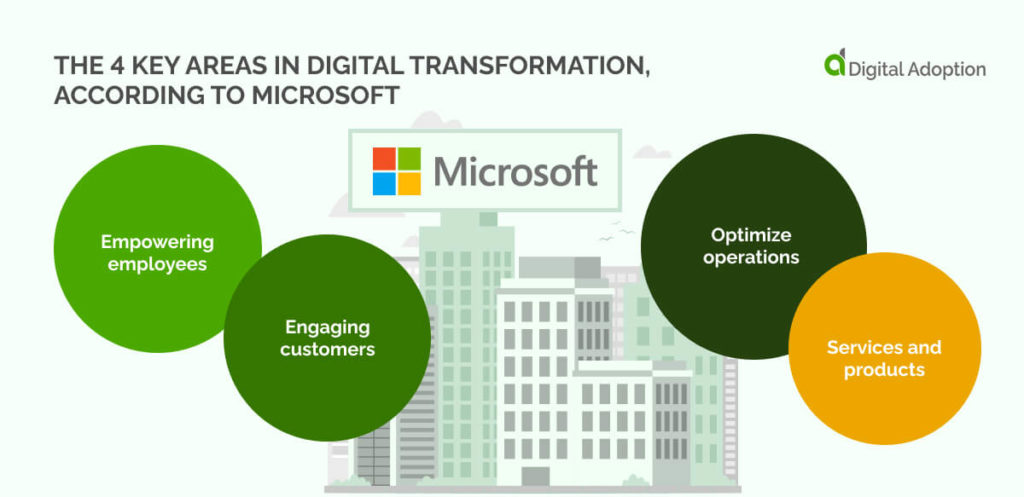
The 4 Main Areas of Digital Transformation, According to Association Success
According to an article on AssociationSuccess.org, a leadership development and consulting firm, businesses should have 4 specific focal points when designing a digital transformation plan:
- A strategic focus that aligns the digital transformation effort with the organization’s overall strategy
- A customer focus that helps the organization create a customer experience that is consistent, unified, and modern
- A culture focus that ensures the workforce has the proper mindsets, attitudes, and behaviors to accommodate transformations
- A data focus that ensures the company can use data and analytics to make informed decisions, enhance business process transformation, and more
A digital transformation plan that emphasizes these areas will be well-rounded, helping organizations design strategies that improve internal operations, the customer experience, and the organization’s market position.
Four Areas to Consider for Developing Digital Transformation Strategies, According to Consultancy.uk
According to an article on consultancy.uk, an organization should answer a few questions when designing a digital transformation strategy:
- How can we digitally adapt organisational structures to become more digitally mature?
- How can we ensure company-wide digital governance and investments?
- What are the skills, competencies and roles required for a digital business model?
- What cultural shift is required to build a fundamental advantage over digital competitors?
Ultimately, digitalization and digital transformation marks the transition from analog to digital.
Older companies that are “analog-native” can face significant obstacles along that journey, which is why it is so important to create a robust digital transformation plan.
Four Focus Areas for Digital Transformation in Treasury Services, According to EY
When it comes to digital transformation in more specific industries – namely, treasury services – the consulting firm EY recommends focusing on:
- Streamlined onboarding. For banks, onboarding is crucial and can mean the difference between gaining and losing a customer.
- Improved insights. Accurate, current information is no longer a luxury for corporate treasury clients – it is a must.
- Enhanced client experience. Along with the rest of the digital economy, corporate treasury services must create a streamlined customer experience across all channels and services.
- Product innovation. EY agrees with Microsoft by stating that product innovation should be a central pillar in digital transformation, helping to offer unprecedented value to the end client.
In treasury services, as well as other industries, digital transformation can open up new frontiers for both banks and their customers. Adhering to the four principles covered here can ensure that banks stay modern, competitive, and digitally mature.
Four Key Areas for Digital Transformation in Procurement
According to Nic Walden, director of advisory services at The Hackett Group, businesses in the procurement industry should focus on:
- The stakeholder experience. Top performers personalize the stakeholder experience across multiple channels, look for value above and beyond savings, and segment the stakeholder community.
- Build a procurement-as-a-service portfolio. In particular, organizations should place resources globally and provide purchase-to-pay and sourcing offerings, while also rebranding to reflect these added functions.
- Analytics, data, and insight. With the right data and analytics, procurement can become more than just an “isolated, siloed” organization – it can become an advisor that offers insights and market intelligence.
- Accelerate transformation with technology. Modern and emerging technology, such as RPA and cognitive computing, can improve profitability and efficiency.
In the digital age, procurement stands to gain a great deal from digital transformation – and, given the rapid pace of change in today’s business process transformation, the sooner that they begin their journey, the better.
Digital Transformation Strategy
A digital transformation strategy is a set of actions that lead to the desired outcome, which can be defined as improving customer experience and business performance. The digital transformation process consists of three phases: digital vision, strategy, and execution.
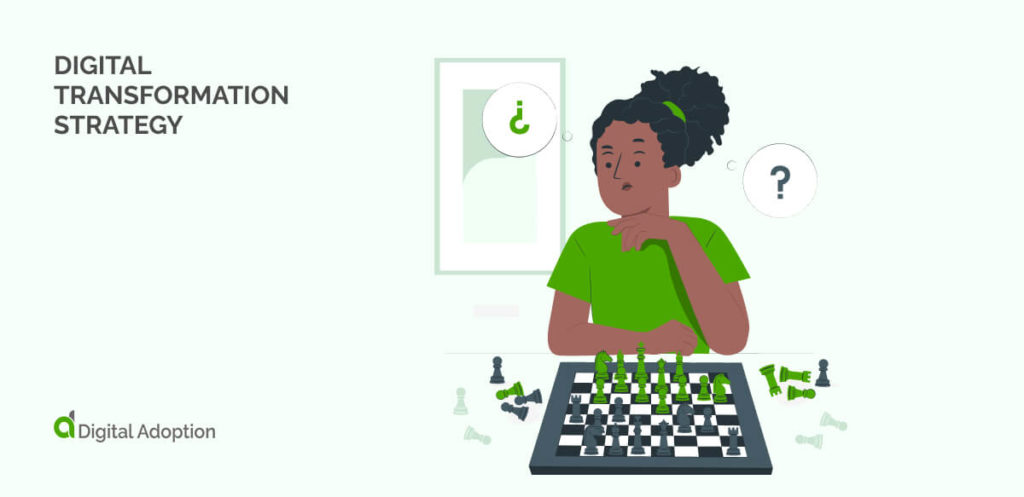
The first phase involves defining your overall vision for your company. You want to ensure that you clearly define what success looks like for your organization. In other words, you need to figure out what type of company you want to be. Will it be a tech-focused company, a healthcare provider, a financial institution, etc.?
Once you decide on the type of company you want, you need to identify your core values. These values represent the foundation of your company and will guide everything that happens throughout the rest of the process. For example, if your company’s core value is “customer satisfaction,” then you must ensure that every employee understands this value and lives it every day.
Next, you need to develop a detailed digital strategy that defines exactly what steps you need to take to your final destination. This includes identifying the specific tactics you plan to implement, such as creating a mobile app or launching a social media campaign.
Finally, you need to execute your strategy. This means you need to implement the plans and monitor whether they work. You may find some strategies aren’t working as well as expected, so you must adjust accordingly.
Digital Transformation Examples
Digital transformation examples include companies such as Amazon, Google, Apple, Facebook, Netflix, Zappos, Walmart, Target, and many others. Each of these companies has its own unique story, but they all share one common trait – they have been able to transform themselves over time.
Amazon was founded in 1994 and was primarily known for selling books online. However, by 2000, it had become the world’s largest retailer. Today, Amazon sells almost anything imaginable, including clothing, electronics, toys, furniture, food, etc.
Google started off as a search engine in 1998. By 2004, it became the world’s leading web portal. Today, Google dominates the search market and provides a wide range of other services, including email, maps, music, video, cloud storage, and more.
Apple began as a computer manufacturer in 1976. It wasn’t until 1997 that Steve Jobs returned to the company and transformed it into a consumer electronics powerhouse. Today, Apple is best known for its iPhone, iPad, Mac computers, and iPod devices.
Facebook was created as a way for students at Harvard University to keep in touch with each other. Since then, it has grown into a global phenomenon with 1.6 billion users worldwide.
Netflix was founded in 1997 as a DVD rental service. Today, it is the world’s most popular streaming platform.
Zappos was founded in 1999 as a shoe store. Today, it is one of the world’s biggest eCommerce sites.
Walmart was founded in 1962 as a small discount grocery chain. Today, it operates as an international retail giant with stores across the globe.
Target was founded in 1902 as a mail order catalog business. Today, it is a major department store chain.
These companies were once just ordinary businesses. They didn’t know how to use technology to their advantage. But through years of trial and error, they learned how to adapt and grow.
Digitalization
Digitalization is a key driver for the future of our economy. It will create new jobs, improve productivity and boost growth. But it also brings challenges: digital skills shortages, data protection issues, cybersecurity risks, and the need to ensure that public services are accessible and affordable.
The European Commission has launched its Digital Single Market Strategy (DSMS) in order to address these challenges. The strategy aims to make Europe more competitive by creating a single market where consumers can shop, work, study, or live anywhere in the EU.
The DSMS is based on three pillars:
- A digital infrastructure that enables people and organizations to access information and communicate freely.
- An open regulatory environment that allows firms to compete globally while protecting citizens from unfair practices.
- A modern industrial base that creates high-quality jobs and promotes innovation.
In this context, the European Union is investing €1 trillion between now and 2023 to build a digitalized society. This includes investments in research and development, networks and infrastructures, education and training, and support for SMEs.
Digital Transformation In Banking
Digital transformation in banking and the rise of digital finance have led to a rapid increase in the use of mobile devices for financial transactions. In fact, according to recent estimates by the World Economic Forum (WEF), there are currently more than 2 billion active accounts held on mobile phones. This number is expected to reach 3.5 billion by 2020.
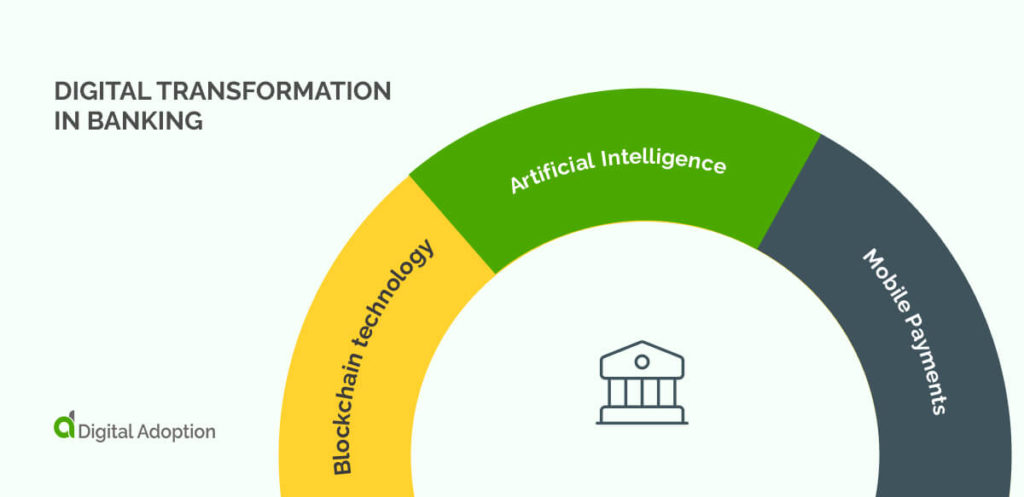
This trend is not only driven by the growing popularity of smartphones but also by the emergence of new technologies such as blockchain and artificial intelligence. These innovations are changing how we interact with money and transforming the traditional financial system.
The future of finance will be a combination of old and new technologies, which means banks need to embrace change to survive. The following three trends will shape this transformation:
Blockchain technology
Blockchain is one of the most disruptive technologies in recent years. It has already changed how people think about digital assets and cryptocurrencies.
Blockchain is an innovative technology that uses cryptography to record transactions securely and transparently. It works like a distributed ledger, meaning that all participants in a transaction can see what happens at any given time. This makes it possible to track ownership of digital assets and prevent fraud.
It also offers other benefits such as increased efficiency, reduced costs, and greater transparency. For example, it could help reduce the cost of cross-border payments.
However, blockchain is still in its early stages, and many questions remain unanswered. Therefore, it is essential to understand the potential impact of this technology before adopting it.
Artificial Intelligence
Artificial Intelligence (AI) is another emerging technology that is revolutionizing the world of finance. AI systems can learn and adapt to changes over time. They are becoming increasingly sophisticated and capable of performing tasks previously considered impossible.
For instance, they can analyze large amounts of data and make predictions based on these insights. As a result, they can improve decision-making and offer better customer service.
They can also automate processes and streamline operations. However, their adoption is limited because of concerns around security and privacy.
Mobile Payments
Mobile payment apps allow users to pay using their smartphone or tablet. This type of payment method is gaining momentum worldwide. According to a study conducted by Accenture, nearly half of global consumers would prefer to pay using their mobile devices rather than cash or cards.
In addition, the number of mobile wallet users is increasing rapidly. For example, Apple Pay was launched in 2014, and today, it has more than 150 million users.
In terms of market size, the US alone accounted for $7.8 trillion in total consumer spending in 2017. By 2023, this figure is predicted to grow to $10.4 trillion.
These figures show just how big the mobile payments industry is becoming. However, it is worth noting that mobile payments are not yet mainstream. Only 5% of Americans have used them regularly.
Digital Transformation Framework
A digital transformation framework is a set of tools and techniques to help organizations achieve their goals in the context of digitalization.
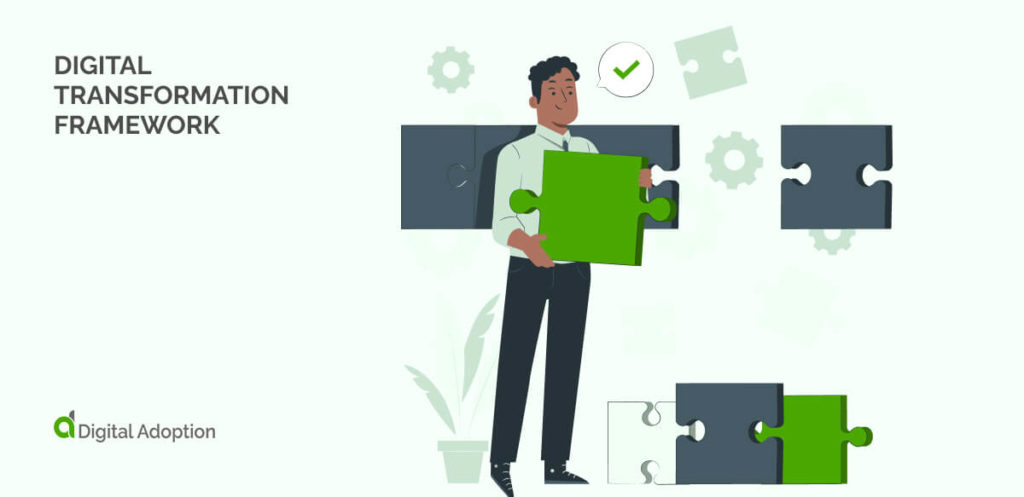
The Digital Transformation Framework (DTF) was developed by the European Commission as part of its Horizon 2020 research program to provide a common language for describing and analyzing digital transformations.
The DTF provides a conceptual model that can be used to understand and analyze digital transformations. It also offers a set of tools and methods to support organizations in implementing digital transformations.
The DTF consists of three components:
- A conceptual model that describes the different phases of a digital transformation.
- A methodology that helps companies identify where they are in relation to their digital transformation journey.
- An action plan that guides companies through the process of developing a strategy for their digital transformation.
Digital Transformation Services
Digital transformation services are a set of activities that help organizations to achieve their digital goals. The term was coined by the McKinsey Global Institute in a report published in 2015. It is defined as “the process of creating new business models, products and services, processes, and organizational structures to deliver value through digital technologies.”
The concept has been widely discussed in recent years. In particular, many experts believe that digital transformation will become an important driver of growth and competitiveness in the future.
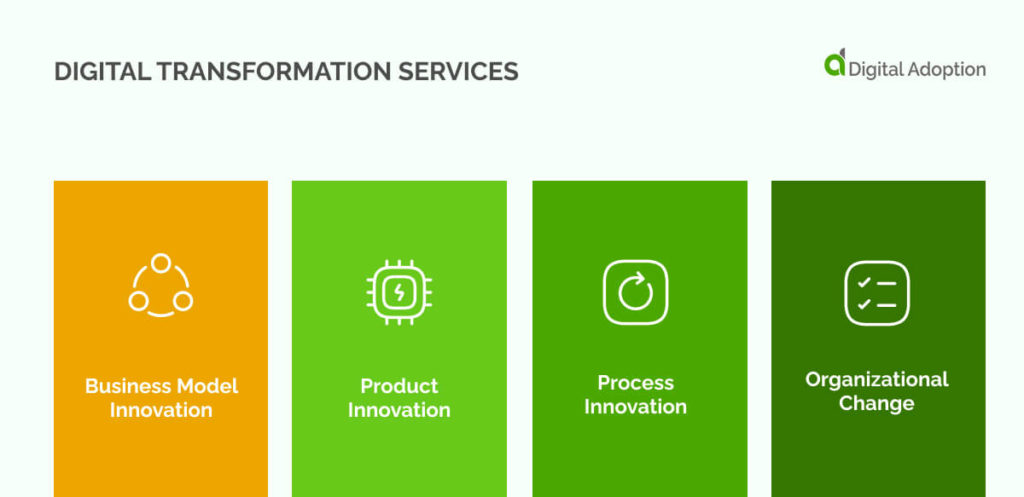
According to McKinsey, there are four key types of digital transformation services:
- Business Model Innovation – This involves changing the way businesses operate. For example, it could include introducing new work methods, such as remote work arrangements.
- Product Innovation – This involves improving existing products and services. For example, it may include changing customer experience, product design, or marketing strategies.
- Process Innovation – This involves changing existing business processes. For example, it might include the introduction of new software systems or the development of new skills.
- Organizational Change – This involves restructuring the organization itself. For example, it includes creating new roles, departments, or divisions.
Digital Transformation Model
A business model transformation is a set of activities designed to help organizations achieve their goals. The model can be used as a framework for planning, designing, and implementing the changes needed in an organization.
The Digital Transformation Model (DTM) was developed by McKinsey & Company based on its experience with more than 100 clients. It consists of five phases:
Phase 1: Define the business problem. This phase includes defining the business’s current state and identifying improvement opportunities.
Phase 2: Design the solution. In this phase, you define your vision for the future. You also decide which parts of the organization need to change.
Phases 3 and 4: Implement the solution. These two phases focus on the implementation of the solutions that have been identified in Phase 2.
Phase 5: Measure results. This phase focuses on measuring the success of the project.
In addition to these five phases, the DTM contains three core elements:
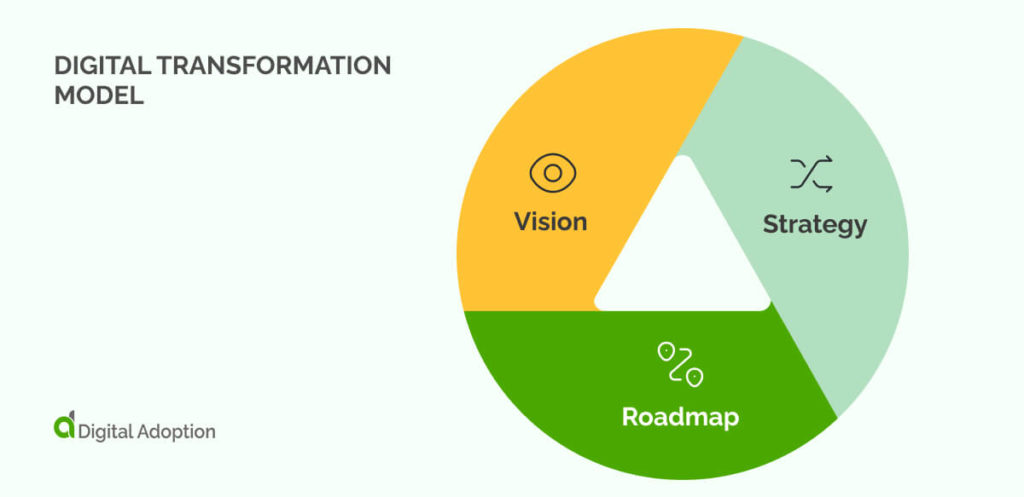
Vision – Your vision defines what you want to accomplish.
Strategy – Your strategy identifies how you intend to get from here to there.
Roadmap – Your roadmap shows how you intend to move forward.
To create a successful digital transformation, it is essential to understand the needs of the company’s customers and employees.
Digital Business Transformation
Digital business transformation is a process of digital innovation that transforms an organization into a digitally-enabled enterprise. It includes using new technologies, processes, and people to achieve a competitive advantage in the digital economy. Digital technology has become ubiquitous in our daily lives.
The Internet of Things (IoT) is one example of how digital technology is changing our world. IoT refers to the interconnection of physical devices, vehicles, buildings, appliances, machines, animals, and other items embedded with electronics, software, sensors, actuators, and network connectivity that enable these objects to collect data and transfer information over networks.
Digital transformation is about creating value through the application of digital technology. Digital transformation requires a shift in mindset, culture, leadership, processes, and capabilities.
Digital transformation is not just about adopting new technologies but transforming how we work, interact, learn, live, and play.
It is important to note that digital transformation is not a single event. Instead, it is a continuous journey that will require many iterations and adjustments along the way.
Digital Transformation Technologies
Digital transformation technologies are tools that can be used to support digital transformation initiatives. They include cloud computing, big data analytics, social media, mobile apps, artificial intelligence, virtual reality, augmented reality, blockchain, the internet of things, machine learning, robotics, and others.
Cloud Computing
Cloud computing is the delivery of computing resources via the internet. Cloud computing allows users to access applications, content, and storage online. The user does not own the server or hardware but instead rents them from the provider.
Big Data Analytics
Big data analytics analyzes large volumes of data using advanced analytical techniques.
Social media is a form of electronic communication where individuals share ideas, news, opinions, messages, etc., by posting text, images, videos, links, and other multimedia content on websites and blogs.
Mobile Apps
Mobile apps are programs designed for smartphones and tablets. These apps allow users to perform specific tasks such as making phone calls, sending emails, taking pictures, playing games, listening to music, watching movies, browsing the web, reading books, etc.
Artificial Intelligence
Artificial intelligence (AI) is the science of building systems that think like humans. AI uses algorithms, statistical models, and human knowledge to mimic human decision-making.
Virtual Reality
Virtual reality (VR) is a computer simulation of real environments. VR headsets display 3D graphics that create the illusion of being present in another place.
Augmented Reality
Augmented reality (AR) overlays digital information in the real world. AR devices project digital information onto the environment around you.
Internet of Things (IoT)
The Internet of Things is a term used to describe the idea that everyday objects have unique identifiers. Every object has at least one sensor that collects and transmits data over a network.
Robotics
Robotic process automation is the use of robots to automate tasks traditionally performed by people. Robots can do repetitive jobs more efficiently than humans.
Machine Learning
Machine learning is a field of computer science that allows computers to learn without being explicitly programmed.

Digital Transformation Outcomes
Digital transformation outcomes are the results of implementing digital technology. Five key factors shape digital transformation outcomes:
1. The type of business model
The type of business model determines how much control the organization has over its operations. For example, a service-based company may have less control over its operations than a manufacturing firm.
2. The Organizational Structure
The organizational structure defines how work gets done within the organization. A flat organization may be better suited to a startup than a hierarchical organization.
3. The culture
Culture refers to the way employees interact with each other and their customers. Culture affects how well employees collaborate and communicate.
4. Technology
Technology refers to the tools and processes used to run the business. Technology influences everything from customer experience to employee productivity.
5. The Leadership Style
Leadership style refers to the behaviors exhibited by leaders. Leadership styles vary based on the needs of the organization. supply chain management auto insurance business model.
Key Takeaways
- Digital transformation is the process of adopting new technologies to improve the efficiency and effectiveness of existing processes.
- Digital transformation is about creating value through the application of digital technologies.
- Digital transformation requires a change in mindset, culture, and leadership.
- The five strategic areas of domain transformation are customers, competition, data, innovation, and value.
- Finetuning business models is key to staying ahead of the game.
In the digital age, procurement stands to gain a great deal from digital transformation – and, given the rapid pace of change in today’s business process transformation, the sooner that they begin their journey, the better.


